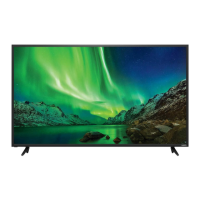
Do you have a question about the Vizio D43-E2 and is the answer not in the manual?
| Screen shape | Flat |
|---|---|
| Response time | - ms |
| Display diagonal | 42.5 \ |
| Display brightness | - cd/m² |
| Display technology | LED |
| Native aspect ratio | 16:9 |
| Native refresh rate | 120 Hz |
| LED backlighting type | Full-Array |
| Contrast ratio (dynamic) | 200000:1 |
| Display number of colors | 16.78 million colors |
| Motion interpolation technology | - |
| Dynamic contrast ratio marketing name | Brilliant Contrast |
| Ambient light sensor | Yes |
| 3D | No |
| Audio decoders | DTS |
| RMS rated power | 20 W |
| Number of speakers | 2 |
| HDMI ports quantity | 3 |
| DVI-D ports quantity | 0 |
| USB 2.0 ports quantity | USB 2.0 ports have a data transmission speed of 480 Mbps, and are backwards compatible with USB 1.1 ports. You can connect all kinds of peripheral devices to them. |
| Ethernet LAN (RJ-45) ports | 1 |
| On Screen Display (OSD) languages | ENG, ESP, FRE |
| Product color | Black |
| Panel mounting interface | 100 x 100 mm |
| Power consumption (standby) | 0.5 W |
| Power consumption (typical) | 27.3 W |
| Package depth | 135.95 mm |
| Package width | 1059.94 mm |
| Package height | 735.84 mm |
| Package weight | 11500 g |
| Sustainability certificates | ENERGY STAR |
| Remote control type | XRT122 |
| Depth (with stand) | 210.06 mm |
|---|---|
| Height (with stand) | 624.59 mm |
| Weight (with stand) | 8300 g |
| Depth (without stand) | 67.06 mm |
| Width (without stand) | 969.52 mm |
| Height (without stand) | 569.72 mm |
| Weight (without stand) | 8000 g |
Register your VIZIO product for support and warranty information.
Information on purchasing VIZIO's on-site extended warranty service plans.
Essential guidelines for safe installation, use, and maintenance of the VIZIO TV.
Measures to protect the TV from lightning strikes and power surges.
Guidance on locating antennas away from overhead power lines.
Locates and explains the function of the remote sensor and power indicator.
Identifies and describes all ports and connections on the back of the TV.
Step-by-step guide for replacing the batteries in the TV remote control.
Explains how to use the remote's arrow buttons and OK button to navigate menus.
Instructions on how to switch between different connected devices like DVD players or game consoles.
Fine-tuning picture settings like Black Detail, Backlight Control, and Reduce Signal Noise.
Guide to changing the white balance of the picture for different viewing conditions.
Instructions for adjusting and saving custom picture modes.
How to save personalized picture settings for different viewing scenarios.
Securing custom picture modes with a PIN to prevent accidental changes.
Steps to remove custom picture modes that are no longer needed.
Restoring edited picture modes to their original factory default settings.
Detailed adjustments for HSB color, white balance, and color channels.
How to display SMPTE, Flat, and Ramp test patterns for calibration purposes.
Customizing audio frequencies using presets or creating a custom equalizer setting.
Procedure for removing custom audio modes created via the equalizer settings.
Configuring the TV's sleep timer to automatically turn off after a set period.
Managing the feature that turns off the TV after a period of no signal.
Setting the time delay before the screen saver activates to save energy.
Instructions to turn off the screen while audio is playing to save energy.
Steps to connect the TV to a wireless network using its SSID and password.
Fine-tuning network settings like IP address and DNS server manually.
Locating the TV's MAC addresses required for router configuration.
Procedure for connecting to a wireless network whose SSID is not broadcast.
Verifying the TV's network connection status, signal strength, and speed.
Choosing between Antenna (Over-the-air) or Cable for TV signal input.
Initiating an automatic scan to find available broadcast and cable channels.
Removing unwanted channels from the channel list for easier navigation.
Selecting alternate audio languages (SAP) for analog broadcasts.
Customizing the style, size, color, and opacity of digital closed captions.
Accessing technical data and status information about the TV and its network connection.
Selecting the preferred language for the TV's on-screen menus.
Configuring the TV's time zone and daylight saving settings for accurate time display.
Adjusting how the video content fits the screen when menus are displayed.
Enabling and configuring CEC to control connected HDMI devices with the TV remote.
Controlling the illumination of the TV's power indicator light.
Activating or deactivating the program rating feature to manage content access.
Methods for locking specific channels to prevent viewing without a PIN.
Using the Rating Block feature to block content based on its rating level.
Procedure for changing the PIN to enhance parental control security.
Restoring all parental control locks and settings to their original factory defaults.
Steps to reset all TV settings, including V.I.A. Plus Apps, to factory defaults.
Accessing and launching V.I.A. Apps from the main dock.
Using dedicated remote keys to quickly launch specific V.I.A. Apps.
Managing and viewing V.I.A. Apps in a full-screen interface.
Instructions for adding desired V.I.A. Apps to the personal 'My Apps' list.
Steps to remove apps from the 'My Apps' list for customization.
Organizing the 'My Apps' tab by repositioning installed applications.
Solutions for frequent problems like remote issues, no signal, no power, and poor image/sound quality.